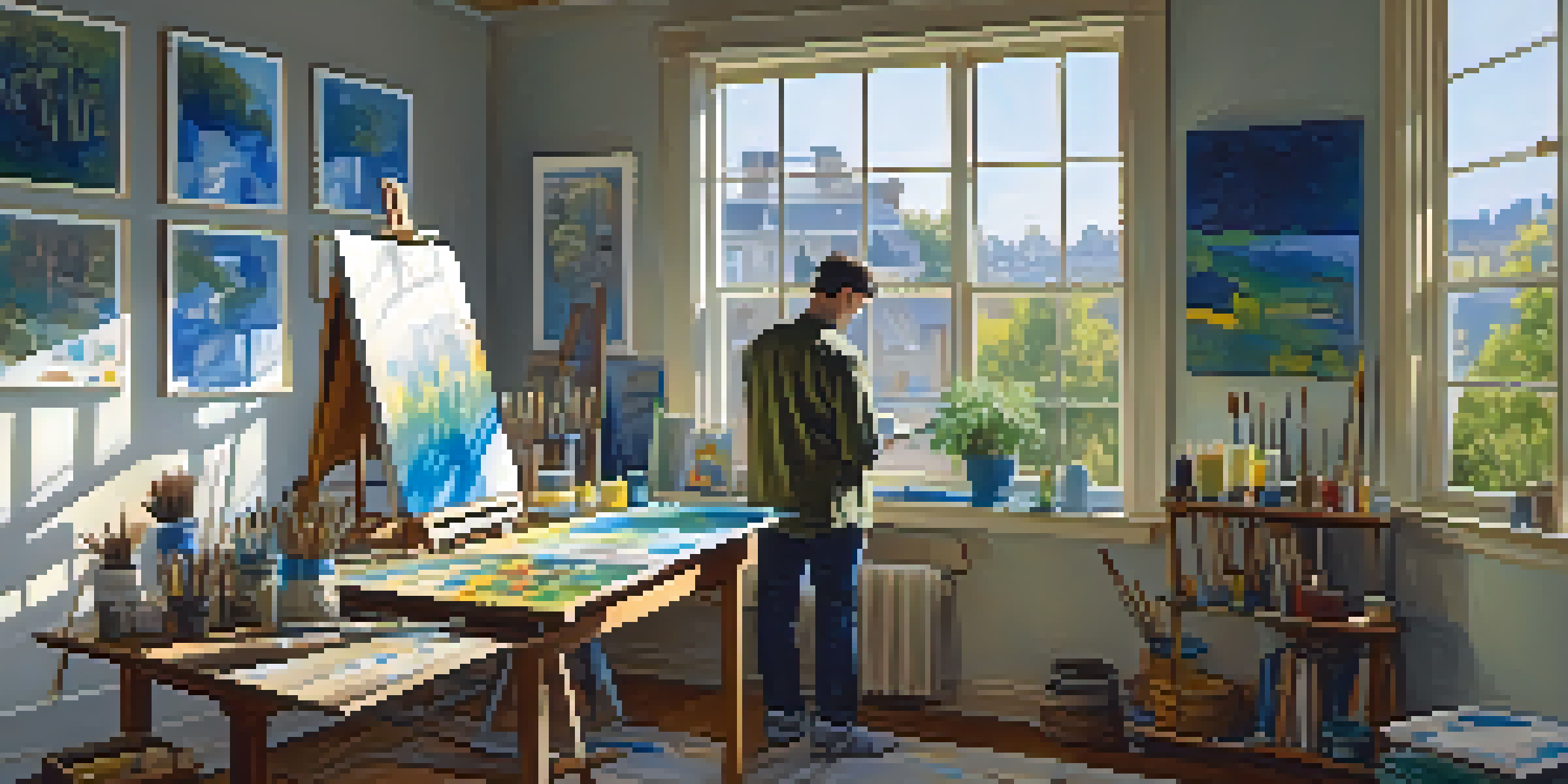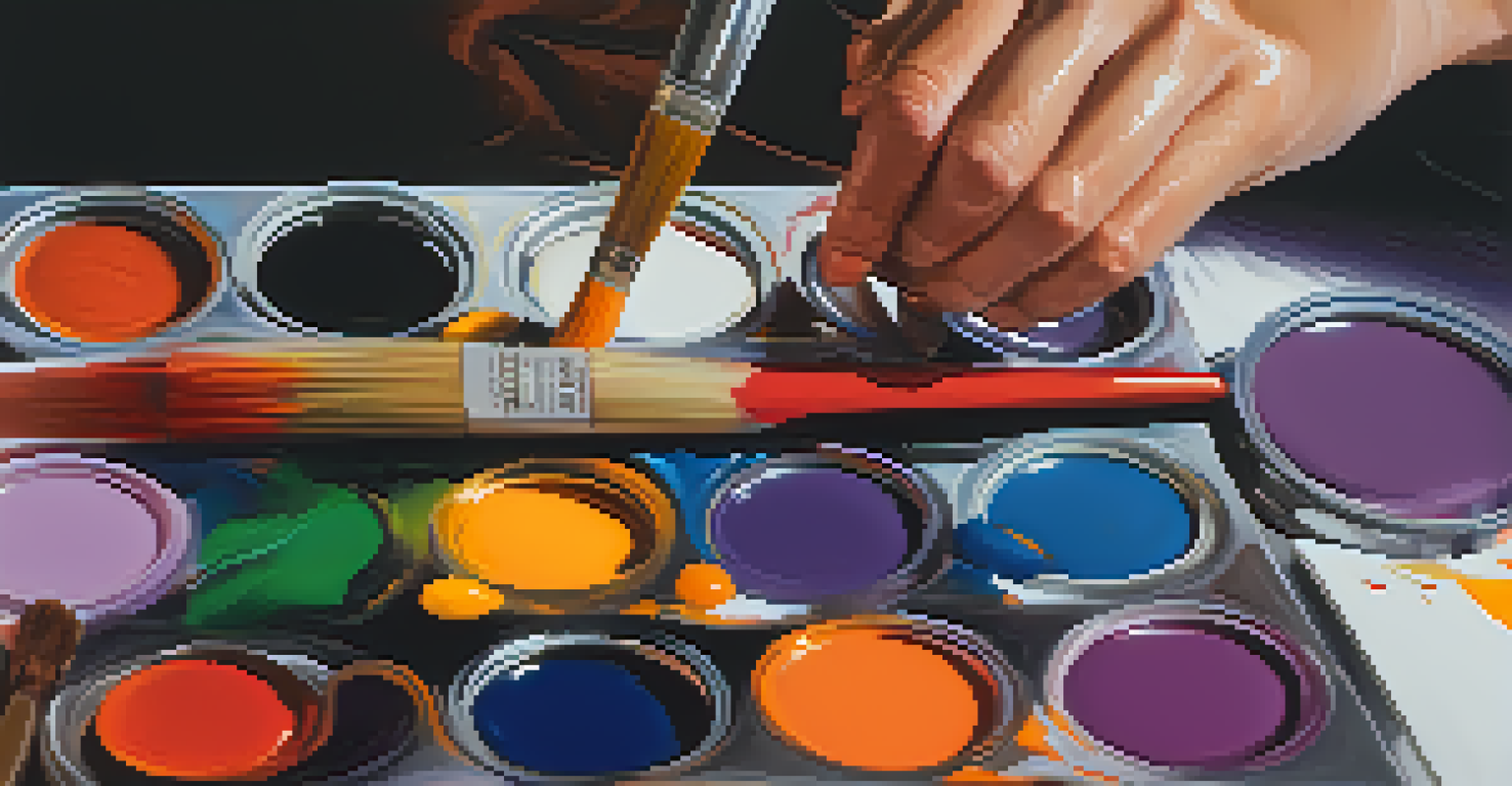Exploring How Marijuana Influences Artistic Expression and Ideas

Understanding Marijuana's Effects on the Brain
Marijuana contains compounds called cannabinoids, which interact with the brain's endocannabinoid system. This system plays a crucial role in regulating mood, memory, and perception. When consumed, marijuana can alter a person's sensory experiences and cognitive functions, sometimes leading to enhanced creativity. Artists often report that these changes help them think outside the box, allowing for a more fluid artistic process.
Creativity is not a talent; it is a way of operating.
It's important to note that everyone reacts differently to marijuana. While some may find that it sparks new ideas or enhances their focus, others might feel distracted or anxious. This variability means that marijuana can be a helpful tool for some artists while being counterproductive for others. Understanding one's own response to marijuana is key in determining its potential benefits for creativity.
Research suggests that moderate use might lower inhibitions and encourage a more open mindset. This can lead to experimentation and risk-taking in art, which are essential components of creative expression. By embracing these altered states of consciousness, artists can tap into deeper layers of their imagination and produce works that resonate on multiple levels.
Historical Perspectives on Marijuana and Art
Throughout history, many renowned artists have embraced marijuana as a catalyst for their creativity. For instance, the Beat Generation writers and musicians of the 1950s and 1960s often used marijuana to inspire their work, leading to a cultural shift in artistic expression. Their experiences helped to shape a narrative that linked marijuana with groundbreaking art, music, and literature.

Similarly, the Surrealist movement of the early 20th century leaned heavily on altered states of consciousness. Artists like André Breton and Salvador Dalí sought inspiration from dreams and hallucinations, often using substances, including marijuana, to achieve these states. This demonstrates how marijuana has long been intertwined with artistic exploration and the quest for deeper understanding.
Marijuana Enhances Artistic Creativity
Cannabinoids in marijuana can alter sensory experiences and cognitive functions, potentially enhancing creativity for some artists.
Moreover, many contemporary artists continue to reference marijuana in their work, whether through themes of liberation or social commentary. This ongoing tradition highlights marijuana's enduring influence on the artistic landscape, as creators draw from their experiences with the substance to inform their art and connect with audiences.
Marijuana and the Experience of Flow in Art
The concept of 'flow' refers to a mental state where individuals are fully immersed in an activity, often resulting in heightened creativity and productivity. Many artists report that marijuana can help them achieve this state more readily. By reducing self-consciousness and anxiety, marijuana allows artists to focus entirely on their creative process.
The best way to predict the future is to create it.
When in a flow state, artists often lose track of time and experience a sense of effortless engagement with their work. This can lead to surprising discoveries and innovative ideas that might not have emerged otherwise. Marijuana can enhance this experience by heightening sensory perceptions, making colors appear more vivid or sounds more resonant, further enriching the artistic process.
However, achieving flow with marijuana isn't guaranteed. The effects vary widely among individuals, and factors such as dosage and environment play significant roles. Artists must find the right balance to harness the potential of marijuana in their creative practices without letting it become a distraction.
Marijuana's Role in Collaborative Creativity
Collaboration is a vital aspect of the artistic process, and marijuana can enhance this experience for some artists. Sharing a joint can create a relaxed atmosphere, fostering open communication and a sense of camaraderie. This social element can lead to the exchange of ideas that might not have surfaced in a more conventional setting.
When artists collaborate under the influence of marijuana, they often experience a shift in dynamics. The substance can lower inhibitions and encourage risk-taking, making it easier to propose unconventional ideas. This playful environment can result in unique artworks that reflect the synergy between the collaborators' visions.
Historical Ties Between Art and Marijuana
Many iconic artists throughout history have used marijuana to inspire their work, linking it to significant cultural movements.
However, it's essential for artists to establish boundaries and maintain focus during these collaborative sessions. While marijuana can facilitate creativity, it can also lead to distractions if not managed well. Setting intentions and goals for the collaboration can help ensure that the creative process remains productive and enjoyable.
Marijuana and Its Impact on Artistic Styles
Many artists have observed a shift in their artistic style when using marijuana. The substance can lead to experimentation with different techniques and mediums, encouraging artists to push the boundaries of their work. This exploration often results in styles that are more abstract or unconventional, reflecting the altered state of consciousness that marijuana can induce.
For example, some painters may find themselves using bolder colors or more erratic brushstrokes while under the influence. This can create a stark contrast to their typical style, allowing them to express emotions and ideas in new ways. In this sense, marijuana acts as a tool for artistic evolution, helping artists break free from creative ruts.
Additionally, marijuana can influence the themes explored in art. Many artists find themselves drawn to topics related to nature, spirituality, or social issues when using the substance. This thematic exploration can lead to thought-provoking pieces that resonate with audiences on a deeper level, showcasing the powerful connection between marijuana and artistic expression.
The Challenges of Using Marijuana in Art
While marijuana can inspire creativity, it also comes with its own set of challenges for artists. One significant concern is the potential for overindulgence, which can lead to diminished focus and productivity. Artists may find that excessive use hampers their ability to create, turning what was once a helpful tool into a hindrance.
Moreover, the stigma surrounding marijuana use can affect how artists are perceived in their work. Some may fear that being open about their marijuana use could undermine their credibility or alienate potential audiences. This societal pressure can create internal conflicts for artists, making it difficult to navigate their creative journeys.
Balancing Marijuana in Art Practices
Artists need to find a balance in using marijuana, understanding its effects on creativity while managing potential distractions.
Finally, the legal status of marijuana varies widely across regions, which can complicate its use for artists. In areas where marijuana remains illegal, artists may face legal repercussions or difficulty accessing the substance. This uncertainty can lead to frustration, as artists seek ways to harness creativity without running afoul of the law.
Finding Balance: Integrating Marijuana into Artistic Practice
For artists looking to incorporate marijuana into their creative practices, finding balance is key. It's essential to understand one's own limits and preferences, as well as how marijuana affects individual creativity. Keeping a journal to track experiences with marijuana and art can help artists identify patterns and make informed decisions about its use.
Additionally, creating a conducive environment for artistic expression while using marijuana can enhance the experience. This might involve setting up a dedicated workspace, surrounding oneself with inspiring materials, or involving like-minded individuals who share similar creative goals. A supportive environment can make it easier to tap into the potential of marijuana without succumbing to distractions.

Ultimately, the relationship between marijuana and artistic expression is deeply personal. Artists must navigate their own journeys and find what works best for them. By embracing a mindful approach, they can harness the power of marijuana to enhance their creativity and produce meaningful, authentic art.